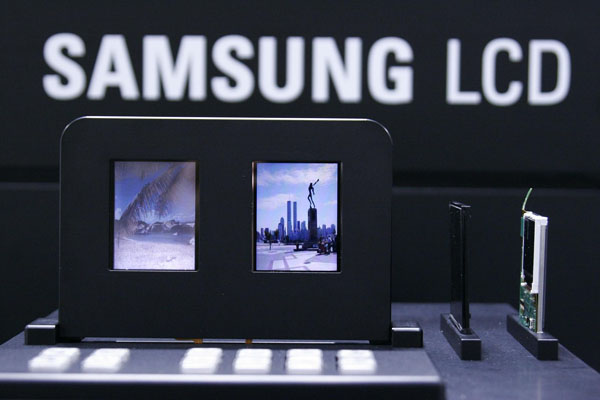
12:22:40 PM
 |
| Home � Reviews � Forums � News 2015 � 2013 � 2012 � 2009 � 2008 � 2007 � 2006 � 2005 � 2004 RSS Feeds � FOV Factor Table � Sensor Sizes | Definitions: A-D � E-H � I-L � M-P � Q-U � V-Z | Sitemap Articles � Archived Websites (Pre-DigitalDingus): D100 Lounge � E-10 Club | Contact |
| Samsung Develops First Truly Double-sided LCD | ||||||||||||||||||||||||||||||
| January 3, 2007 | ||||||||||||||||||||||||||||||
Origin Of News Release: Seoul, South Korea Original Release Date: January 3, 2007 Announcement: Double-sided LCD MSRP: Not Available (OEM manufacturing) Availability: Mass production for manufacturers: first half of 2007 Samsung Electronics Co., Ltd. , the world's largest provider of thin-film transistor, liquid crystal display (TFT-LCD) panels announced today that it has created the first LCD panel that can produce independent images on each side of a mobile LCD display. Samsung's new double-sided LCD can show two entirely different pictures or sets of visual data simultaneously on the front and back of the same screen. Other conventional double-sided LCDs can only show a reverse image of the same video data. This new development will replace two display panels with one, thereby reducing overall thickness of mobile products by at least 1mm. Executive Vice President Yun Jin-hyuk, in charge of the Mobile Display Division of the Samsung Electronics LCD Business, says, "Our new double-sided mobile display underscores Samsung's commitment to equip our customers with advanced display technology that accelerates the trend toward slimmer mobile products. We anticipate high demand when we commence mass production in the first half of 2007." The breakthrough LCD product makes use of Samsung's new double-gate, thin-film transistor (TFT) architecture. TFT gates are electronic components that convert the necessary voltage at the pixel level, which controls the liquid crystal alignment needed to reproduce on-screen images. Samsung's new double-sided LCD has two gates that operate each pixel instead of one, so the screen on the front can display different images than the one on the back. The double-sided display makes use of Samsung's proprietary Amorphous Silicon Gate (ASG) technology, which accommodates the increased number of TFT gates without increasing the size of the driver integrated circuits. Driver-ICs typically increase in size when more TFT gates are used. The new Samsung mobile display requires only one backlight, while competitive double-screen LCDs require two. One side of the panel operates in a transmissive mode, while the other operates in a reflective mode. By using a unique reflective design that utilizes the light trapped in the opposing screen's transmissive mode, the reflective mode does not solely rely on external light sources such as the sun. The double-sided, dual image LCD's efficient use of light to display images in both transmissive and reflective modes promotes slimmer, more cost-effective products. The new double-sided LCD is 2.6mm thick and 2.22" wide, with QVGA (240 x 320 pixel) resolution, and has brightness values of 250 nits for the front and 100 nits for the rear display. It will be exhibited at the Consumer Electronics Show, which opens in Las Vegas on January 8.
About Samsung Electronics Samsung Electronics Co., Ltd. is a global leader in semiconductor, telecommunication, digital media and digital convergence technologies with 2005 parent company sales of US$56.7 billion and net income of US$7.5 billion. Employing approximately 128,000 people in over 120 offices in 57 countries, the company consists of five main business units: Digital Appliance Business, Digital Media Business, LCD Business, Semiconductor Business and Telecommunication Network Business. Recognized as one of the fastest growing global brands, Samsung Electronics is a leading producer of digital TVs, memory chips, mobile phones and TFT-LCDs. For more information, visit http://www.samsung.com. Reference Data 1 pixel, 2 transistors: A pixel design that allows separate control of the liquid crystal on the transmissive and reflective sides, enabling both sides to display separately. Double gates: The gate is a transistor element to which voltage is applied to turn on or off the circuit that provides the signal needed to drive the LCD. Normally, one circuit is needed for every pixel to make a single screen function, but Samsung's new double-screen LCD has two gates to control each pixel, a necessary condition for allowing the same pixel to be used for two different screens. Amorphous silicon (a-Si): Non-crystalline form of silicon Transmissive mode: Transmissive mode uses a backlight through the liquid crystal cells to display the images to the viewer. Reflective mode: Reflective mode uses external light such as the sun to display the images to the viewer. Nit: An abbreviation for the measure of brightness, also referred to as "candela per square meter", or cd/m(2). Resolution formats for small and mid-sized LCDs qqVGA: 128 pixels horizontal by 160 rows vertical qCIF: 176 pixels horizontal by 220 rows vertical qVGA: 240 pixels horizontal by 320 rows vertical qSVGA: 300 pixels horizontal by 400 rows vertical VGA: 480 pixels horizontal by 640 rows vertical
| ||||||||||||||||||||||||||||||
| Home � Reviews � Forums � News 2015 � 2013 � 2012 � 2009 � 2008 � 2007 � 2006 � 2005 � 2004 RSS Feeds � FOV Factor Table � Sensor Sizes | Definitions: A-D � E-H � I-L � M-P � Q-U � V-Z | Sitemap Articles � Archived Websites (Pre-DigitalDingus): D100 Lounge � E-10 Club | Contact |